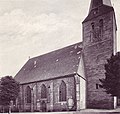St. Andreas (Lübbecke)
The today Evangelical-Lutheran parish church St. Andreas in Lübbecke is one of the original parishes of the diocese of Minden .
Building history
The originally single-nave, cross-shaped building with a west tower was probably built between 1160 and 1180 in the Romanesque style. In 1350, by adding two aisles, it was converted into a Gothic hall church. This change in style is still clearly visible inside the church. As the dating inscription stone from 1350 indicates in Latin, the plague raged in Lübbecke in the same year, for which the Jews of the city (as elsewhere) were held responsible as the alleged perpetrator (translation of the inscription for example: "In 1350, when the plague was when the Geisler passed through and the Jews were killed, this church was also expanded "). During the restoration carried out in 1959-62, remains of wall and ceiling paintings were uncovered inside, some of which date from the 13th century. The furnishings include a gothic baptismal font in the shape of a cup, a life-size crucifix ( triumphal cross ) made around 1200 and an organ front from 1628, which was expanded in 1642. In addition, a number of epitaphs have been preserved. The tower is almost 70 m high, making it one of the tallest church towers in a small town.
history
The collegiate St. Andrew in Lübbecke was before it was moved in 1295 after Lübbecke, in the year 1274 when John chapter Ahlden been founded on the Aller. In 1280 it was first moved to Neustadt am Rübenberge and in 1295 to Lübbecke for security reasons. The local St. Andrew's Church was elevated to a collegiate monastery. In 1550 the Reformation was introduced to St. Andrew and the church became a Lutheran parish church. The chapter became simultaneous, in 1624 there were five Lutheran and one Roman Catholic canons. The collegiate foundation was not abolished until 1810 by the French government in Kassel ( Kingdom of Westphalia ). The stones of the former Meeseburg , which was located on the summit of the Meesenkopf in the Wiehen Mountains , are said to have been used for the construction of the church .
Altar with Westphalian Last Supper
On the altar is a carved representation of the last supper of Jesus with his disciples. The group was originally designed in color. On the right side the disciple Judas is shown with a purse in his hand (Judas betrayed Jesus for 30 pieces of silver according to the Bible). In contrast to the biblical description, bread and wine are not distributed: suckling pig and green core soup can be seen on the plate. Here, as in the Wiesenkirche in Soest, a Westphalian supper is presented with typical Westphalian dishes .
Others
Until the construction of the church in Oberbauerschaft in 1899, the inhabitants of this place, which is located south, i.e. on the other side of the Wiehen Mountains, had to attend the service in Lübbecke, i.e. on this side of the Wiehen Mountains. A forest path to Lübbecke, the old church path and a separate entrance door on the north side of the Andreas Church in Lübbecke bear witness to this historical circumstance. Since the end of 2008, the tower of the church has been illuminated from outside by spotlights.
literature
- Helmut Hüffmann: The St. Andreas Church in Lübbecke . On the history of the community and the monastery. Uhle & Kleimann, Lübbecke 1990.
- Karl-Jürgen Kemmelmeyer: On the history of the St. Andreas Church Lübbecke and its organs . Ed .: Ev.-Luth. Lübbecke parish, Lübbecke organ building association, Lübbecke city archive. 2018.
- Maria Spahn: The Collegiate Foundation St. Andreas zu Lübbecke . A contribution to the history of the city (= Mindener Geschichtsverein [Hrsg.]: Mindener contributions to the history, regional and folklore of the former principality of Minden . Volume 17 ). Minden History Association, Minden 1980.
- Maria Spahn: Lübbecke. Collegiate Foundation St. Andreas . In: Karl Hengst (Hrsg.): Westfälisches Klosterbuch . Lexicon of the monasteries and monasteries established before 1815 from their foundation to their abolition (= Historical Commission for Westphalia [Hrsg.]: Sources and research on church and religious history . Volume 2 ). tape 1 . Aschendorff , Münster 1992, ISBN 978-3-402-06886-1 , p. 546-550 .
Individual evidence
- ^ Helmut Hüffmann: Church and Abbey St. Andreas in Lübbecke. A contribution to the duty of patronage. Communications of the Mindener Geschichtsverein, year 54 (1982), pp. 71–86.
- ↑ Westfälisches Klosterbuch, vol. 1, p. 546f.
- ^ Maria Spahn: The deposition of the canon JC Hoyer. Announcements of the Minden History Society, year 51 (1979), pp. 101-108.
- ↑ Formally, the upper peasantry was only spun off from the Lübbecke parish on January 1, 1971 and became an independent parish. Until then, the services were held by a pastor provided by Lübbecke in the church building there, which thus had the status of a chapel.
Web links
Coordinates: 52 ° 18 ′ 5.6 ″ N , 8 ° 37 ′ 6.1 ″ E






